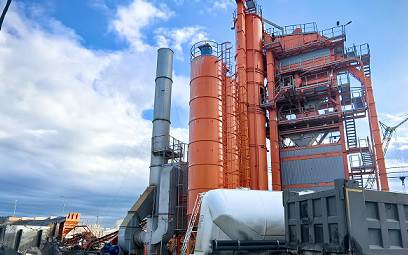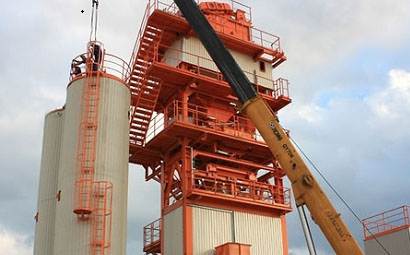When choosing an asphalt mixing plant, don't just look at the price, but also pay attention to the product quality, after all, the quality directly affects the service life of the asphalt plant. As for problems such as equipment failures, our company has combined years of project experience to analyze the causes of failures in asphalt concrete mixing plants, which are summarized as follows:
1. Unstable output and low equipment production efficiency
During the construction and production of many projects, there will be such a phenomenon: the production capacity of the asphalt plant is seriously insufficient, the actual production capacity is far lower than the rated production capacity, the efficiency is low, and even the progress of the project schedule is affected. Our company's work clothes experts explained that the main reasons for such failures in asphalt mixing plants are as follows:
(1) Improper mixing ratio
Everyone knows that the mix ratio of our asphalt concrete is the target mix ratio and the production mix ratio. The target mix ratio is to control the proportion of sand and gravel cold material delivery, and the production mix ratio is the mixing ratio of various sand and stone materials in the finished asphalt concrete material specified in the design. The production mix ratio is determined by the laboratory, which determines the grading standard of the finished asphalt concrete. The target mix ratio is set to further guarantee the production mix ratio, and it can be adjusted according to the actual situation during the production process. When the target mixing ratio or production mixing ratio is incorrect, the raw materials stored in each metering of the mixing station will be disproportionate, and some overflow materials, some other materials, etc., cannot be measured in time, resulting in the idling state of the mixing tank, and the production efficiency is naturall low.
(2) Unqualified gradation of sand and stone aggregates
The sand and stone aggregates used in the production of asphalt mixtures have a gradation range. If the feed control is not strict and the gradation seriously exceeds the range, a large amount of "waste" will be generated, which will cause the weighing bin to fail to weigh accurately in time. Not only does it result in low output, but it also causes a lot of waste of raw materials, which increases the cost unnecessarily.
(3) The moisture content of sand and stone is too high
When we purchase asphalt mixing equipment, we know that its production capacity matches the equipment model. However, when the moisture content in the sand and stone aggregates is too high, the drying capacity of the equipment will decrease, and the amount of sand and gravel aggregates that can be supplied to the metering bin to reach the set temperature in a unit time will decrease accordingly, so that the output will decrease.
(4) Fuel combustion value is low
The fuel used in the asphalt mixing plant has certain requirements, generally burning diesel, heavy diesel or heavy oil. Some construction units are trying to save money during construction, and sometimes burn mixed oil. This kind of oil has a low combustion value and generates less heat, which seriously affects the heating capacity of the drying cylinder and reduces the production capacity. This seemingly cost-reducing method actually causes even greater waste!
(5) Improper setting of operating parameters of asphalt mixing equipment
The unreasonable setting of operating parameters of asphalt mixing equipment is mainly reflected in: improper setting of dry mixing and wet mixing time, unreasonable adjustment of opening and closing time of bucket door. In general, each stirring production cycle is 45s, which just reaches the rated production capacity of the equipment. Take our LB2000 type asphalt mixing equipment as an example, the mixing cycle is 45s, the output per hour is Q=2×3600/45=160t/h, the mixing cycle time is 50s, the output per hour is Q=2×3600/ 50=144t/ h (Note: The rated capacity of 2000 type mixing equipment is 160t/h). This requires us to shorten the mixing cycle time as much as possible under the premise of ensuring quality during construction.


2. The discharge temperature of asphalt concrete is unstable
During the production of asphalt concrete, the temperature requirements are very strict. If the temperature is too high, the asphalt is easy to "burn" (commonly known as "paste"), and it has no use value and can only be thrown away as waste; if the temperature is too low, the asphalt and gravel will stick unevenly and become " White material". We assume that the cost per ton of material is generally about 250 yuan, then the loss of "paste" and "gray material" is quite astonishing. In an asphalt concrete production site, the more waste materials are discarded, the lower the management level and operational capacity of the site will be. There are two main reasons for the instability of the finished product discharge temperature:
(1) Asphalt heating temperature control is inaccurate
As mentioned above, if the temperature is too high, it will become "paste", and if the temperature is too low, it will be "gray material", which is a serious waste.
(2) The temperature control of sand aggregate heating is not accurate
Unreasonable adjustment of the flame size of the burner, or failure of the damper, changes in the water content of the sand and gravel aggregate, and lack of material in the cold storage bin, etc., can easily cause waste. This requires us to observe carefully, make measurements frequently, have a high sense of quality responsibility and strong execution during the production process.
3. Oil-stone ratio is unstable
The asphalt ratio refers to the ratio of asphalt quality to sand and other fillers in asphalt concrete, and is the most important indicator to control the quality of asphalt concrete. If the asphalt-stone ratio is too large, "oil cake" will appear on the road surface after paving and rolling; if the asphalt-stone ratio is too small, the concrete material will diverge, and the rolling will not form, all of which are serious quality accidents. The main reasons are:
(1) The soil/dust content in the sand and gravel aggregate seriously exceeds the standard
Although the dust is removed, the mud content in the filler is too large, and most of the asphalt is combined with the filler, which is commonly known as "oil absorption". There is less asphalt adhered to the surface of the gravel, and it is difficult to form after rolling.
(2) Measurement system failure
The main reason is that the zero point of the measurement system of the asphalt measurement scale and the mineral powder measurement scale drifts, resulting in measurement errors. Especially for asphalt weighing scales, an error of 1kg will seriously affect the asphalt ratio. In production, the metering system must be calibrated frequently. In actual production, due to the many impurities in the mineral powder, the door of the mineral powder metering bin is often not closed tightly, and leakage occurs, which seriously affects the quality of asphalt concrete.
4. Dust is large, polluting the construction environment
During construction, some mixing plants are full of dust, which seriously pollutes the environment and affects the health of workers. The main reasons are:
(1) The amount of mud/dust in the sand and gravel aggregate is too large, seriously exceeding the standard.
(2) Dust removal system failure
At present, asphalt mixing plants generally use bag dust removal, which is made of special materials with small pores, good air permeability, and high temperature resistance. The dust removal effect is good, and it can meet environmental protection requirements. There is a disadvantage - expensive. In order to save money, some units do not replace the dust bag in time after it is damaged. The bag is seriously damaged, the fuel is not completely burned, and impurities are adsorbed on the surface of the bag, causing blockage and causing dust to fly in the production site.
5. Maintenance of asphalt concrete mixing plant
The maintenance of the asphalt concrete mixing plant is generally divided into the maintenance of the tank body, the maintenance and adjustment of the winch system, the adjustment and maintenance of the stroke limiter, the maintenance of the wire rope and the pulley, the maintenance of the lifting hopper, the maintenance of the track and the track support, etc. wait.
On the construction site, the concrete mixing plant is a frequent and prone to failure equipment. We must strengthen the maintenance of the equipment, which is conducive to ensuring the safe construction of the site, improving the equipment integrity rate, reducing equipment failure, ensuring the quality of concrete, and improving equipment. Production capacity, get a double harvest of social and economic benefits.
 Albanian
Albanian  Russian
Russian  Arabic
Arabic  Amharic
Amharic  Azerbaijani
Azerbaijani  Irish
Irish  Estonian
Estonian  Odia (Oriya)
Odia (Oriya)  Basque
Basque  Belarusian
Belarusian  Bulgarian
Bulgarian  Icelandic
Icelandic  Polish
Polish  Bosnian
Bosnian  Persian
Persian  Afrikaans
Afrikaans  Tatar
Tatar  Danish
Danish  German
German  French
French  Filipino
Filipino  Finnish
Finnish  Frisian
Frisian  Khmer
Khmer  Georgian
Georgian  Gujarati
Gujarati  Kazakh
Kazakh  Haitian Creole
Haitian Creole  Korean
Korean  Hausa
Hausa  Dutch
Dutch  Kyrgyz
Kyrgyz  Galician
Galician  Catalan
Catalan  Czech
Czech  Kannada
Kannada  Corsican
Corsican  Croatian
Croatian  Kurdish (Kurmanji)
Kurdish (Kurmanji)  Latin
Latin  Latvian
Latvian  Lao
Lao  Lithuanian
Lithuanian  Luxembourgish
Luxembourgish  Kinyarwanda
Kinyarwanda  Romanian
Romanian  Malagasy
Malagasy  Maltese
Maltese  Marathi
Marathi  Malayalam
Malayalam  Malay
Malay  Macedonian
Macedonian  Maori
Maori  Mongolian
Mongolian  Bengali
Bengali  Myanmar (Burmese)
Myanmar (Burmese)  Hmong
Hmong  Xhosa
Xhosa  Zulu
Zulu  Nepali
Nepali  Norwegian
Norwegian  Punjabi
Punjabi  Portuguese
Portuguese  Pashto
Pashto  Chichewa
Chichewa  Japanese
Japanese  Swedish
Swedish  Samoan
Samoan  Serbian
Serbian  Sesotho
Sesotho  Sinhala
Sinhala  Esperanto
Esperanto  Slovak
Slovak  Slovenian
Slovenian  Swahili
Swahili  Scots Gaelic
Scots Gaelic  Cebuano
Cebuano  Somali
Somali  Tajik
Tajik  Telugu
Telugu  Tamil
Tamil  Thai
Thai  Turkish
Turkish  Turkmen
Turkmen  Welsh
Welsh  Uyghur
Uyghur  Urdu
Urdu  Ukrainian
Ukrainian  Uzbek
Uzbek  Spanish
Spanish  Hebrew
Hebrew  Greek
Greek  Hawaiian
Hawaiian  Sindhi
Sindhi  Hungarian
Hungarian  Shona
Shona  Armenian
Armenian  Igbo
Igbo  Italian
Italian  Yiddish
Yiddish  Hindi
Hindi  Sundanese
Sundanese  Indonesian
Indonesian  Javanese
Javanese  Yoruba
Yoruba  Vietnamese
Vietnamese  Hebrew
Hebrew  Chinese (Simplified)
Chinese (Simplified)







